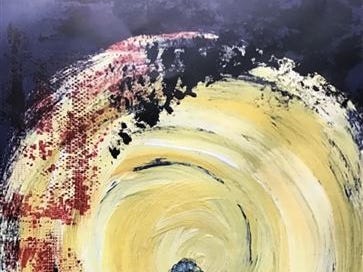I used to walk. Walk and listen and watch. And sometimes cry but often ache. I walked circles, drawing a net around my sorrow, heart pounding, breath ragged, either from the exertion or the pain.
Sometimes I smiled. A cool breeze would caress my cheek like a comforting hand. Miraculous clouds stacked up in the distance, leaning against the brilliant blue. Flocks of birds coming or going, linear journeys. A lonely bunny loping across the field. Once, I found a pheasant feather. I was sure it was a sign. I needed a sign. I took it home and treasured it.
Almost always I walked during the day, unless the pain was too intense to look at. One terrible night I went out, reassured that my familiar path was along a well-traveled road. I may have sobbed on that walk. The moon was full and big, hovering low in the sky. Even through my tears I admired it. It was alone, like me, but beautiful.
Earbuds cocooned me on my wanderings; clever invention, equalizing the pressure inside and out, if only brief relief. Music was tricky. Playlists might tumble me into an abyss, grabbing hold of this memory or that on the way down. Sometimes I marched to anthems of self-sufficiency, but those worked best sung loudly in my car or looking in the steamy morning mirror.
Audiobooks were more effective. Each chapter was an invitation to keep going–find out what happens next. There will be something next if you don’t. give. up. Educated1 hit too close to home at times, but that was also cathartic. The pharisee in me liked to compare: You weren’t that bad. Dolores Claiborne 2was comforting in a macabre way (there will be justice). My favorite was The Graveyard Book3, dramatized, fall air and changing leaves a perfect background. Life continues even beyond death. Bad things happen, lives realign and create new, unexpected, sometimes scary connections.
Surprise! Real life is stranger than fiction. The plot thickens is not a bad thing. Good stories are thick4, gooey, heart-pounding, breath-catching. If you don’t sometimes hold your breath, you can’t breathe a sigh of relief.
by Tara Westover: https://a.co/d/7X9tfVA
by Stephen King: https://a.co/d/6iDz3F6
by Neil Gaiman: https://a.co/d/6CmXoZa
Narrative therapy is an approach that “thickens” the story. People often tell themselves “thin stories,” which leave out context and detail. This may be easier when emotions are high and survival seems paramount. But over time, it’s important to begin to wonder about the other elements of that story, beyond the soundbite version, because survival mode narratives often keep people stuck in trauma, whereas inviting nuance into remembrance helps calm down the shame and the blame that tend to sustain those thin stories. You can learn more about how to do that here: https://www.able-differently.org/helpful-topics/narrative-practice/







Carmon, thanks for sharing this piece. And the particular attention to the physical act of 'walking.' I've always loved walking, and it really changes everything, mind, body, soul.